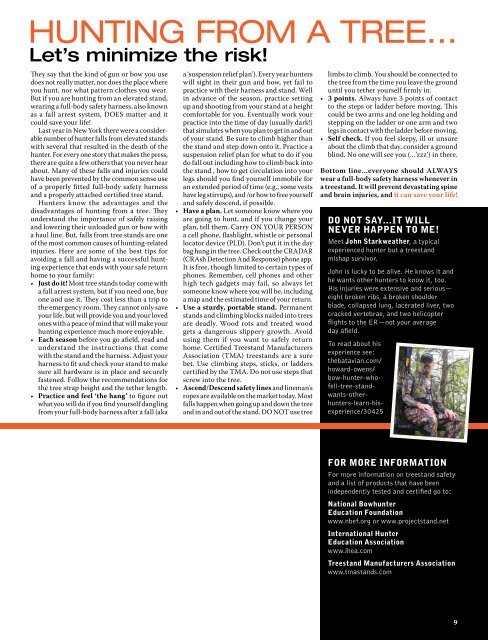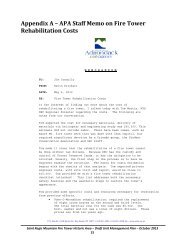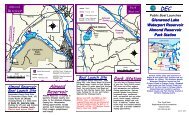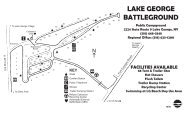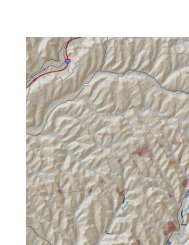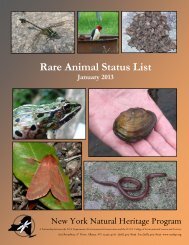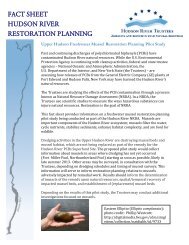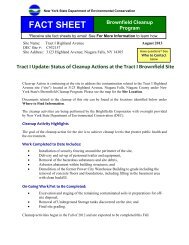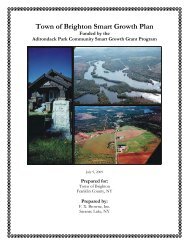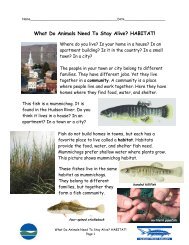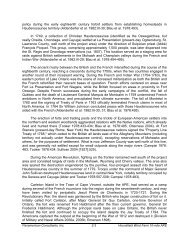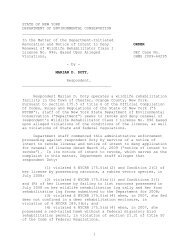2012-2013 Hunting & Trapping Regulations Guide - New York State ...
2012-2013 Hunting & Trapping Regulations Guide - New York State ...
2012-2013 Hunting & Trapping Regulations Guide - New York State ...
Create successful ePaper yourself
Turn your PDF publications into a flip-book with our unique Google optimized e-Paper software.
<strong>Hunting</strong> from a tree…<br />
Let’s minimize the risk!<br />
They say that the kind of gun or bow you use<br />
does not really matter, nor does the place where<br />
you hunt, nor what pattern clothes you wear.<br />
But if you are hunting from an elevated stand,<br />
wearing a full-body safety harness, also known<br />
as a fall arrest system, DOES matter and it<br />
could save your life!<br />
Last year in <strong>New</strong> <strong>York</strong> there were a considerable<br />
number of hunter falls from elevated stands<br />
with several that resulted in the death of the<br />
hunter. For every one story that makes the press,<br />
there are quite a few others that you never hear<br />
about. Many of these falls and injuries could<br />
have been prevented by the common sense use<br />
of a properly fitted full-body safety harness<br />
and a properly attached certified tree stand.<br />
Hunters know the advantages and the<br />
disadvantages of hunting from a tree. They<br />
understand the importance of safely raising<br />
and lowering their unloaded gun or bow with<br />
a haul line. But, falls from tree stands are one<br />
of the most common causes of hunting-related<br />
injuries. Here are some of the best tips for<br />
avoiding a fall and having a successful hunting<br />
experience that ends with your safe return<br />
home to your family:<br />
• Just do it! Most tree stands today come with<br />
a fall arrest system, but if you need one, buy<br />
one and use it. They cost less than a trip to<br />
the emergency room. They cannot only save<br />
your life, but will provide you and your loved<br />
ones with a peace of mind that will make your<br />
hunting experience much more enjoyable.<br />
• Each season before you go afield, read and<br />
understand the instructions that come<br />
with the stand and the harness. Adjust your<br />
harness to fit and check your stand to make<br />
sure all hardware is in place and securely<br />
fastened. Follow the recommendations for<br />
the tree strap height and the tether length.<br />
• Practice and feel ‘the hang’ to figure out<br />
what you will do if you find yourself dangling<br />
from your full-body harness after a fall (aka<br />
a ‘suspension relief plan’). Every year hunters<br />
will sight in their gun and bow, yet fail to<br />
practice with their harness and stand. Well<br />
in advance of the season, practice setting<br />
up and shooting from your stand at a height<br />
comfortable for you. Eventually work your<br />
practice into the time of day (usually dark!)<br />
that simulates when you plan to get in and out<br />
of your stand. Be sure to climb higher than<br />
the stand and step down onto it. Practice a<br />
suspension relief plan for what to do if you<br />
do fall out including how to climb back into<br />
the stand , how to get circulation into your<br />
legs should you find yourself immobile for<br />
an extended period of time (e.g., some vests<br />
have leg stirrups), and /or how to free yourself<br />
and safely descend, if possible.<br />
• Have a plan. Let someone know where you<br />
are going to hunt, and if you change your<br />
plan, tell them. Carry ON YOUR PERSON<br />
a cell phone, flashlight, whistle or personal<br />
locator device (PLD). Don’t put it in the day<br />
bag hung in the tree. Check out the CRADAR<br />
(CRAsh Detection And Response) phone app.<br />
It is free, though limited to certain types of<br />
phones. Remember, cell phones and other<br />
high tech gadgets may fail, so always let<br />
someone know where you will be, including<br />
a map and the estimated time of your return.<br />
• Use a sturdy, portable stand. Permanent<br />
stands and climbing blocks nailed into trees<br />
are deadly. Wood rots and treated wood<br />
gets a dangerous slippery growth. Avoid<br />
using them if you want to safely return<br />
home. Certified Treestand Manufacturers<br />
Association (TMA) treestands are a sure<br />
bet. Use climbing steps, sticks, or ladders<br />
certified by the TMA. Do not use steps that<br />
screw into the tree.<br />
• Ascend/Descend safety lines and lineman's<br />
ropes are available on the market today. Most<br />
falls happen when going up and down the tree<br />
and in and out of the stand. DO NOT use tree<br />
limbs to climb. You should be connected to<br />
the tree from the time you leave the ground<br />
until you tether yourself firmly in.<br />
• 3 points. Always have 3 points of contact<br />
to the steps or ladder before moving. This<br />
could be two arms and one leg holding and<br />
stepping on the ladder or one arm and two<br />
legs in contact with the ladder before moving.<br />
• Self check. If you feel sleepy, ill or unsure<br />
about the climb that day, consider a ground<br />
blind. No one will see you (…’zzz’) in there.<br />
Bottom line…everyone should ALWAYS<br />
wear a full-body safety harness whenever in<br />
a treestand. It will prevent devastating spine<br />
and brain injuries, and it can save your life!<br />
dO nOt saY…it will<br />
never Happen tO me!<br />
Meet John starkweather, a typical<br />
experienced hunter but a treestand<br />
mishap survivor.<br />
John is lucky to be alive. He knows it and<br />
he wants other hunters to know it, too.<br />
His injuries were extensive and serious—<br />
eight broken ribs, a broken shoulder<br />
blade, collapsed lung, lacerated liver, two<br />
cracked vertebrae, and two helicopter<br />
flights to the ER—not your average<br />
day afield.<br />
To read about his<br />
experience see:<br />
thebatavian.com/<br />
howard-owens/<br />
bow-hunter-whofell-tree-standwants-otherhunters-learn-hisexperience/30425<br />
fOr mOre infOrmatiOn<br />
For more information on treestand safety<br />
and a list of products that have been<br />
independently tested and certified go to:<br />
national Bowhunter<br />
education foundation<br />
www.nbef.org or www.projectstand.net<br />
international Hunter<br />
education association<br />
www.ihea.com<br />
treestand manufacturers association<br />
www.tmastands.com<br />
9


